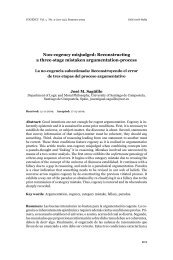Cogency v2 n2
Cogency v2 n2
Cogency v2 n2
Create successful ePaper yourself
Turn your PDF publications into a flip-book with our unique Google optimized e-Paper software.
COGENCY Vol. 2, N0. 2, Spring 2010<br />
point that Wittgenstein is trying to make here, and in similar places throughout<br />
the later works, is just that it is a mistake to understand the semantics of<br />
any particular word in terms of a rigid and necessessitarian ontology associated<br />
with it. Were we to do so we would be, as he says, “mistaking a psychological<br />
compulsion for a logical one”.<br />
It would be tempting to take from this the lesson that pictures and words<br />
are on a par with one another, but Wittgenstein’s remarks here and elsewhere,<br />
as we shall see, make clear that this is a mistake. Words may be like<br />
pictures in that they do not of themselves force a use, but the similarity ends<br />
there. Whereas rules and communal criteria of meaning keep us from falling<br />
into humpty-dumptyism with language, there are no such checks on<br />
picturing, or if there are, their effectiveness falls far short of those accompanying<br />
our usage of language.<br />
3.2. PI 422-427<br />
These passages occur in the context of Wittgenstein’s examination of the<br />
language used to talk about states of consciousness, the vocabulary he sometimes<br />
describes as “psychical” and that some commentators have called the<br />
intentional vocabulary. As we shall see, they support the view of pictures<br />
developed in 193(b) and 194. Begin by considering the text of 422-3:<br />
422. What am I believing in when I believe that men have souls? What<br />
am I believing in, when I believe that this substance contains two carbon<br />
rings? In both cases there is the picture in the foreground, but the sense<br />
lies far in the background; that is, the application of the picture is not<br />
easy to survey.<br />
423. Certainly, all these things happen in you.–And now all I ask is to<br />
understand the expression we use. –The picture is there, and I am not<br />
disputing its validity in any particular case. –Only I also want to understand<br />
the application of the picture. (Wittgenstein 1968: 126)<br />
In terms of pictures, 422 continues the notion of 193-4. Pictures, unlike<br />
112








